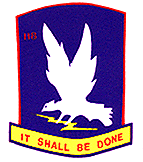 |
|
|
|
|
|
|
|
|
|
|
|
|
|
|
|
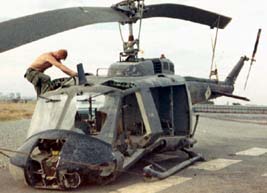
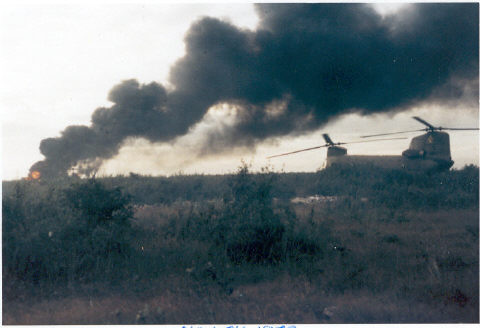
|
|
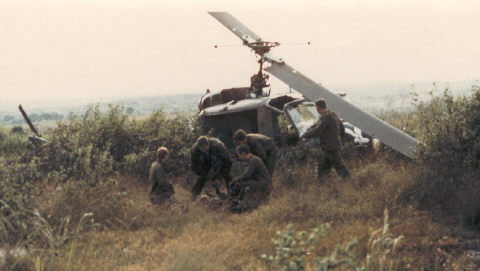
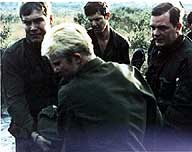
| "I was in the trail bird and was co-pilot to Dale (Trail) Moore. We had just formed up with the flight when the mid-air happened. Dale had just given me the controls when it happened. I was concentrating on staying in formation, so only saw some of it happen." |
|
"You (Duane Speirs) must have had a ring side seat that day! I know that I, as AC in the left seat, could not see what was going on the right side of the aircraft as you, my pilot, could see. (Remember, not co-pilot! We had no co-pilots then). I remember the rotor system of chalk 2 spinning off, and the tail boom falling away, with the crew cabin doing a slow roll to the right as it fell to earth. It exploded into an orange flame and then black and brown. As we descended, chalk 3, CPT Al said over the radios that his aircraft was following chalk 2 down. I told CPT Al to get back up there and lead the flight on, which he did. (I, a WO1 and not even at that point a CW2, should tell a CPT what to do!) We landed near where chalk 2 had fallen and exploded. I told our crewchief to get out and see if anyone had fallen or jumped from chalk 2. He did, and in head high grass, was out of my sight in seconds. About two seconds after he disappeared, I began to worry. Had I sent him out on a mission that may kill him, or worse? Finally he returned and said that it was just too hot with ammo exploding, to continue. I was so glad to get him back I didn't care what he had done! We then flew over to where lead had gone down. I did not expect it to be any different from what we had seen at chalk 2's location. The lead aircraft seemed to be intact as we landed. And unlike before, I elected to be the one to go over to see how they were. The pilot seemed to be OK, but stated that he thought his wrist might be broken. I went to the left side of the aircraft and CPT Lemieux looked at me and said "Dale, I had no control over this thing!" I looked down at the left tail rotor peddle and it was bent to the FLOOR!! I have no idea how many pounds of force would be needed to do that, but much more than I have in me. Sorry if I have brought back some bad memories." Dale Moore |
|
"I didn't like Duc Hoa for lunch because we always parked close to the artillery and of course they would always get a fire mission while we were there. Those 105s cracked so sharp that even with the flight helmets on, it hurt the ears. I was flying as Crew Chief in "The Fabulous Blue 7" with Thunderbird 29er, Lyman Sramek, as AC, a Peter Pilot( I don't remember his name), and Gunner, SP4 George Gomez. We had been flying trail and were responsible to monitor guard frequency in case there was some kind of emergency while we were on the ground." "After we had time to complete lunch, a couple of the guns took off to go cover the ARVNs. Not too long later, while hiding from the hot sun on the shady side of the chopper, we got the word to scramble. After take-off we learned that a Bandit was down and we were to recover the crew. They were saying the Bandit got shot down and we gotta go pick them up. The other gun team was right behind us. Adrenaline and butterflies were going wild inside!" "Just a few minutes out of Duc Hoa we located the crash site and the other guns were reconing the area by fire. On the guns and ready for what is sure to come, we head in. The crash site is freshly burned rice paddies with brush and small trees to one side and pretty well open on the other. The closer we get, Bandit 3 clearly is just a bunch of bent up scrap metal scattered around." |
.jpg)
|
At first we didn't see anyone and feared the worst for the crew. Gomez and I jumped off and went in search for them. The Peter Pilot we found first sitting on the ground some distance from the wreckage. He is all cut up on the face and head and somewhat wobbly and woozy, but we walk him to the slick. Then out again. Finally, we spot the Crew Chief in the tall grass. He is not so good. His left leg has about 5 or 6 knees. As carefully as we can, we quickly carry him to Blue 7 and lay him inside on the floor(I find out later his pelvis is broken, also.) We looked up, ready to head out to look for others and what? Here is the gunner sitting in the chopper. Other than black ash all over him and a half inch cut on the forehead, he seems OK! George was having a tough time handling the broken bodies and I'm not doing too well myself. He stays to help the three injured on Blue 7 while I head out again to look for the missing man, the Aircraft Commander, CWO Carl Martin Creal. The damage is incredible! The tail boom was separated and laying to one side. The engine had been torn away and was laying out in the field. The fuselage was standing straight up. Everything was black with soot. As I went back and was looking around, I couldn't understand where WO Carl Creal could be. Then I went back to the fuselage and looked up at it. The top of the cockpit was gone, but then I saw him, still strapped in the seat and hanging nearly upside down with no helmet on. I just about lost it. There seemed to be no major injury other than a large deep wound in his head over his left eye. After I had assured myself that he was in fact dead, I left and hurried back to the waiting chopper. The others really needed to get to Saigon and medical attention. When I was plugged back in to the intercom, WO Lyman Sramek asked where CWO Creal was. I just said he was dead and the crash site was secure. We high tailed it to the hospital in Saigon. |
.jpg)
|
"On the way into Saigon, the injured Bandit 3 Gunner (Dennis Surop, a CE acting as a Gunner that day) waved his hand at me to get my attention. I leaned over to hear what he wanted. He said, "Norton, don't let my foot fall out of the chopper." Again, I about lost it as I looked and saw what he was talking about. His right foot was 2-3 inches inside the cargo area and his left foot was just going over the edge and falling out! With no bone to hold it together, there was only flesh holding it inside the aircraft! As carefully as I could, I got it back inside and as close to where it should be and then put my foot in the way to keep it there the rest of the flight. Then he asked me were CWO Creal was. I couldn't bring myself to say, so I just drew my finger across my throat. The despair on his face just about made me cry." "Once we were back at the crash site, we learned that another aircraft had picked up WO Carl Creal and taken him back to Bien Hoa. We were told to go get the guns and radios. When we arrived the ARVNs were poking around. We looked over the crash site and got what we were after. Since we had been there last, someone had knocked over the fuselage onto its top, apparently removing CWO Creal's body. The word "KILL" that was written on the bottom was now clearly visible." |
.jpg)
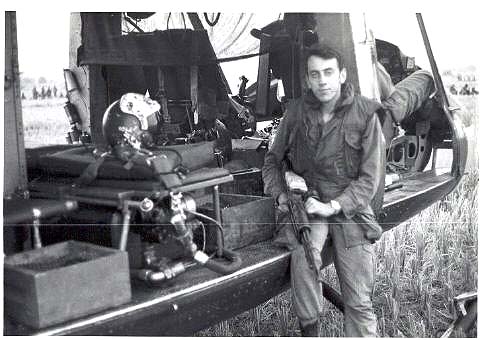
|
145th Bn Operational Report
7) Removal of Pilot/Co-pilot Doors on
UH-1 Aircraft |
|
Bob Hoffman remembering when he returned for his 2nd tour writes, "At that time(1969) the entire 145th BN was not flying with any cargo or pilots doors on the aircraft. I asked why, and as I recall, was told that it was a 12th Group decision and that the reason was that it afforded better visibility and prevented the possibility of the cargo doors coming off and going into the rotor system. Needless to say, we had some radio problems. " "Apparently there had been a mid air that was attributed to poor visibility from the pilot's compartment and was the moving force in this decision." "Having flown both with the doors off and on I have to say that I preferred them on. It was a bit cooler owing to the increased airflow, but you also had to keep everything secured and the visibility was not much, if any, better. When flying in rain you got a lot more moisture inside then with the doors on...... I didn't like it." |
